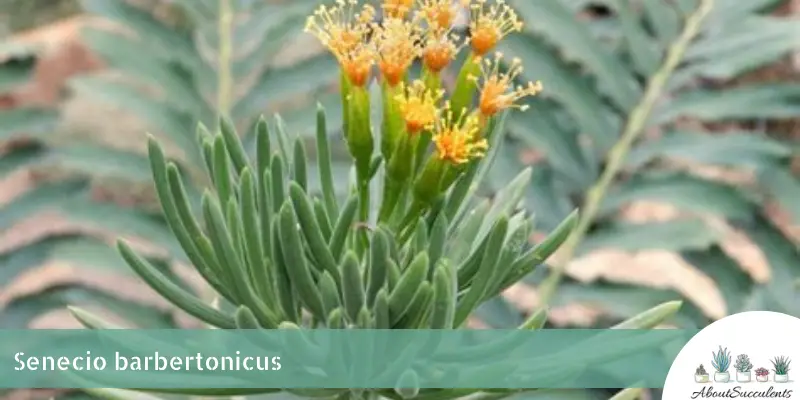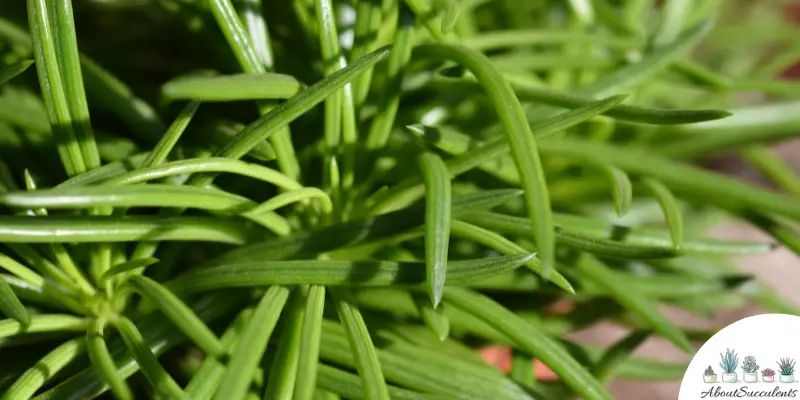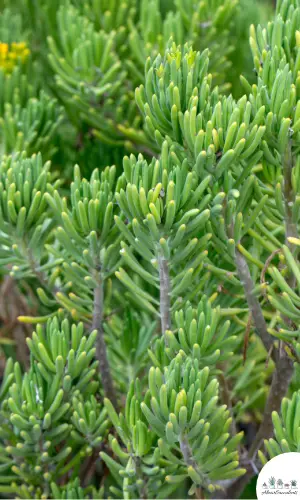
Senecio barbertonicus is an evergreen succulent plant that’s readily identifiable by its thick-banded bushes with finger-like leaves. This is a succulent that can grow to a height of 2m (6.5’) but in some cases, there are Senecio barbertonicus that have grown to 3m (10’).
Senecio barbertonicus is known by its alias, Succulent Bush Senecio but it also goes by other names such as Finger-leaved Senecio, Barberton Senecio, and Lemon Bean Bush.
Succulent Bush Senecio’s leaves are thick, cylindrical, and densely packed near the stem and the color hue varies from bright green to olive green. The leaves are 5-10cm (2-4”) long and 5-10mm (0.2 – 0.4”) in diameter.
Unlike most types of succulents that go dormant in winter, Finger-leaved Senecio blooms clusters of golden-yellow flowers that resemble daisies and emit a nice fragrance.
The flowers measure 10mm (0.4”) and 75mm (3”) long and appear on the tips of the branches. They also produce fruits that are 3-5mm (11-19”) with a ribbed texture and cylindrical shape.
Senecio barbertonicus is native to South Africa and can be found growing mostly in sub-tropical woodland and grassy regions such as Zimbabwe, Mozambique, and Swaziland. Succulent Bush Senecio is a member of the Asteraceae family.
General Information:
Also known as: Succulent Bush Senecio, Finger-leaved Senecio, Lemon Bean Bush
Plant Family: Asteraceae
Origin: South Africa
Height: 2m (6.5’)
Exposure: Full to partial sun of up to 6 hours
Water Needs: Drought-tolerant succulent only needs water when the soil is completely dry.
Soil Type: Well-draining mix with pumice, perlite, or sand to improve the level of drainage.
Soil pH: Not particular; can thrive in a wide variety of soil pH levels.
How to Grow and Care for Senecio Barbertonicus

Senecio barbertonicus is an excellent addition to your garden especially when it’s paired with other types of succulent plants with similar finger-like leaves such as Euphorbia tirucalli and Rubber euphorbia.
Succulent Bush Senecio can also be used to adorn your home as an indoor succulent. Just keep in mind that this plant can grow into a mini-tree and will need to be pruned at the top to keep it from falling over.
Other than that, this is a variety of succulent that are easy to grow and care for.
Sunlight
Senecio barbertonicus can thrive in a desert environment and needs to get plenty of sunlight. As an outdoor succulent, the ideal location would be an area that regularly gets 6 hours of morning sunlight per day.
If your region experiences temperature drops to below -1.1° C (30° C), we recommend growing Finger-leaved Senecio in a pot that can be moved indoors. Place the pot near a window that receives 4 to 6 hours of partial sunlight every day.
Watering
This is a drought-tolerant succulent that can survive the harsh conditions of the desert – but not overwatering.
Senecio barbertonicus can go for a month without water. If you water it more than what’s needed, the roots will rot and the plant will develop a fungal infection.
The simple rule to follow is to water Succulent Bush Senecio only when you can prove that the soil is completely dry.
You can do this by inserting a stick into the soil. If the end of the stick feels dry after you pull it out, then the soil is ready to get soaked thoroughly.
Remember to water the soil and not the plant. The best time to water Senecio barbertonicus is from 8:00 am to 10:00 am.
Pot and Soil

Senecio barbertonicus can grow tall and heavy. Be ready to change pots once the succulent hits a growth spurt. Re-potting usually takes place every 2-3 years.
Choose a pot that’s made of ceramic or terracotta to ensure proper evaporation of moisture from the soil.
The pot must have a drain hole with a mesh cover to allow excess water to come out when you’re giving the soil a thorough watering.
Senecio barbertonicus is a durable succulent and can tolerate poor quality soil and a wide range of pH levels.
For best results, plant the succulent in a well-draining potting mix and add ingredients such as perlite, pumice, and sand to further relieve excess moisture from the soil.
You can also add fertilizer to improve soil nutrition but choose brands that are low in nitrogen but have good levels of phosphorus and potassium.
How to Propagate Senecio Barbertonicus
You can propagate Senecio barbertonicus via leaf and stem cuttings. Summer and spring are the ideal seasons for propagation.
Method 1: Leaf Cuttings
Step 1: Choose a healthy-looking leaf from the main stem of the plant.
Step 2: Cut the leaf with a sterilized and sharpened pair of garden shears.
Step 3: Place the leaf cuttings in a warm and dry area where it can develop hard calluses over a period of 2-3 days.
Step 4: When the leaf cuttings have callused over, place them on top of well-draining soil.
Step 5: Keep the soil lightly moist through constant misting but once the cuttings have taken root, give it water only when the soil has completely dried out.
Method 2: Stem
Step 1: Find a stem that has many healthy leaves growing on it.
Step 2: Cut a stem the size of 5cm (2”) by using a sterilized and sharpened pair of garden shears.
Step 3: Leave the stem cutting to dry out and callus over a period of 2-3 days.
Step 4: Place the stem cutting on top of well-draining soil.
Step 4: Mist the soil frequently to keep it moist. Once the roots have grown firm, water the soil only when it’s 100% dry.
Frequently Asked Questions
Is Senecio Barbertonicus Toxic to Cats and Dogs?
Senecio barbertonicus is not on the list of toxic plants identified on the website of the American Society for the Prevention of Cruelty to Animals (ASPCA).
Keep in mind that the list on the website is only partial. There have been findings that Finger-leaved Senecio is toxic to animals once ingested.
If your pet shows signs of weakness and has been vomiting, bring the animal to the veterinarian right away.
Why Is My Senecio Barbertonicus Dying?
If you suspect that your beloved Senecio barbertonicus is growing weaker and might be close to death, the cause might either be overwatering or the presence of pests.
Overwatering
If you give Senecio barbertonicus water while the soil is still moist, its roots will rot and the plant will develop a fungal infection that will spread rapidly.
A clear sign that fungal infection is taking place is discoloration on the leaves or stem of the plant. Once you see this, cut off the infected part with a pair of sanitized garden scissors.
Remove the plant from the pot and shake off the excess soil. Cut off all of the roots that have rotted and let the plant dry off in a warm area.
Fill the pot with fresh soil that is well-draining then repot Succulent Bush Senecio.
Pest Infestation
Mealybugs and other scale insects love the sap from the leaves of Lemon Bean Bush. The succulent plant will grow weak and become susceptible to disease once its sap has been drained.
If you notice white, cotton-like substances growing on the leaves, wipe these off with 70% isopropyl alcohol or insecticide soap. These are signs that mealybugs are living in your plant.
You can also spray Lemon Bean Bush with neem oil to keep the pests away.
Does Senecio Barbertonicus Produce Flowers?
Senecio barbertonicus produces beautiful, daisy-like, golden yellow-colored flowers in the winter that have a mild, sweet fragrance.
Last Updated on June 9, 2022 by Sofia Lara